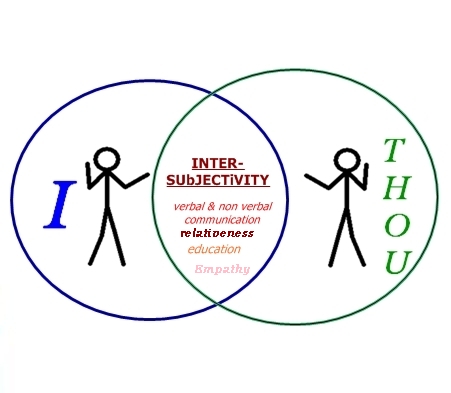Very interesting concept - a neuroscientific explanation of extended mind as it manifests interpersonally and intersubjectively.
Citation:
Hasson, U, Ghazanfar, AA, Galantucci, B, Garrod, S. and Keysers, C. (2012, Feb). Brain-to-brain coupling: a mechanism for creating and sharing a social world. Trends in Cognitive Sciences, Vol. 16, No. 2. doi:10.1016/j.tics.2011.12.007Brain-to-brain coupling: a mechanism for creating and sharing a social worldRead the whole article.
Uri Hasson, Asif A. Ghazanfar, Bruno Galantucci, Simon Garrod, and Christian Keysers
Abstract
Cognition materializes in an interpersonal space. The emergence of complex behaviors requires the coordination of actions among individuals according to a shared set of rules. Despite the central role of other individuals in shaping one’s mind, most cognitive studies focus on processes that occur within a single individual. We call for a shift from a single-brain to a multi-brain frame of reference. We argue that in many cases the neural processes in one brain are coupled to the neural processes in another brain via the transmission of a signal through the environment. Brain-to-brain coupling constrains and shapes the actions of each individual in a social network, leading to complex joint behaviors that could not have emerged in isolation.
Why two (or more) brains are better than one
Although the scope of cognitive neuroscience research is vast and rich, the experimental paradigms used are primarily concerned with studying the neural mechanisms of one individual’s behavioral processes. Typical experiments isolate humans or animals from their natural environments by placing them in a sealed room where interactions occur solely with a computerized program. This egocentric framework is reminiscent of the Ptolemaic geocentric frame of reference for the solar system. From the early days of civilization, stars were not thought to have any influence on the geophysical processes on Earth. The present understanding of gravity, orbits and the tides came about only after the Copernican revolution, which brought about the realization that the Earth is just another element in a complex, interacting system of planets. Along the same lines, we argue here that the dominant focus on single individuals in cognitive neuroscience paradigms obscures the forces that operate between brains to shape behavior.
Verbal communication is an excellent example to illustrate the role that other individuals play in one’s cognitive processes. As Wittgenstein argued, the meaning of a word is defined by its use [1]. The word’s correct use, however, can vary across eras, cultures and contexts. Thus, the appropriate use of a word is grounded in a set of interrelated norms shared by a community of speakers. To master a language, one has to learn the correct uses of words by interacting with other members of the community. Such interactions fundamentally shape the way individuals think and act in the world [2,3]. This is by no means limited to language. Several other nonverbal social and cognitive skills, such as courting, dancing or tool manipulation, require the collaboration of multiple agents that coordinate their behavior according to a shared set of rules and customs. With so many cognitive faculties emerging from interpersonal space, a complete understanding of the cognitive processes within a single individual’s brain cannot be achieved without examining and understanding the interactions among individuals [4]. In this article, we call for a shift from a single-brain to a multi-brain frame of reference.
Brain-to-brain coupling
The premise of brain-to-brain coupling is that the perceptual system of one brain can be coupled to the motor system of another. This binding mechanism builds on a more rudimentary ability of brains to be coupled to the physical world (stimulus-to-brain coupling, Figure 1a). Different objects in the environment emit different forms of energy (mechanical, chemical, electromagnetic), and receptors convert these signals into electrical impulses that the brain can use to infer information about the state of the world and generate appropriate behaviors. Furthermore, organisms are not passive receivers of sensory input but rather actively move their sensory receptor surfaces (hands, eyes, tongues, etc.) to sample information from the environment [5,6]. Thus, stimulus-to-brain coupling is fundamental to the ability to retrieve information about the world to guide actions.
Brain-to-brain coupling also relies on stimulus-to-brain coupling as a vehicle for conveying information. However in brain-to-brain coupling, the signal is generated by another brain and body that resemble one’s own, rather than by inanimate objects in the physical environment (Figure 1b). Brain-to-brain coupling is analogous to a wireless communication system in which two brains are coupled via the transmission of a physical signal (light, sound, pressure or chemical compound) through the shared physical environment.
The coordination of behavior between the sender and receiver enables specific mechanisms for brain-to-brain coupling unavailable during interactions with the inanimate world. For example, seeing or hearing the actions, sensations or emotions of an agent trigger cortical representations in the perceiver (so-called vicarious activations [7,8]). If the agent has a similar brain and body, vicarious activations in the perceiver will approximate those of the agent, and the neural responses will become coupled [7]. If the agent, however, has a brain and body that are fundamentally different from those of the witness, this vicarious activation pattern will look fundamentally different from that in the agent and the brain responses will not be coupled. Vicarious activation, of course, is only one particular mechanism by which the neural responses can be coupled across two brains. In other cases, the neural responses in the receiver can be coupled to the neural responses in the sender in a lawful, but more complex, manner [9].

No comments:
Post a Comment